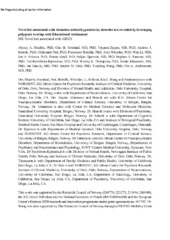Novel loci associated with attention-deficit/hyperactivity disorder are revealed by leveraging polygenic overlap with educational attainment
Shadrin, Alexey A.; Smeland, Olav Bjerkehagen; Zayats, Tetyana; Schork, Andrew J; Frei, Oleksandr; Bettella, Francesco; Witoelar, Aree; Li, Wen; Eriksen, Jon Alm; Krull, Florian; Djurovic, Srdjan; Faraone, Stephen V.; Reichborn-Kjennerud, Ted; Thompson, Wesley K; Johansson, Stefan; Haavik, Jan; Dale, Anders; Wang, Yunpeng; Andreassen, Ole Andreas
Peer reviewed, Journal article
Accepted version
Permanent lenke
https://hdl.handle.net/1956/20183Utgivelsesdato
2018-02Metadata
Vis full innførselSamlinger
Originalversjon
https://doi.org/10.1016/j.jaac.2017.11.013Sammendrag
Objective Attention-deficit/hyperactivity disorder (ADHD) is a common and highly heritable psychiatric condition. By exploiting the reported relationship between ADHD and educational attainment (EA), we aimed to improve discovery of ADHD-associated genetic variants and to investigate genetic overlap between these phenotypes. Method A conditional/conjunctional false discovery rate (condFDR/conjFDR) method was applied to genome-wide association study (GWAS) data on ADHD (2,064 trios, 896 cases, and 2,455 controls) and EA (n=328,917) to identify ADHD-associated loci and loci overlapping between ADHD and EA. Identified single nucleotide polymorphisms (SNPs) were tested for association in an independent population-based study of ADHD symptoms (n=17,666). Genetic correlation between ADHD and EA was estimated using LD score regression and Pearson correlation. Results At levels of condFDR<0.01 and conjFDR<0.05, we identified 5 ADHD-associated loci, 3 of these being shared between ADHD and EA. None of these loci had been identified in the primary ADHD GWAS, demonstrating the increased power provided by the condFDR/conjFDR analysis. Leading SNPs for 4 of 5 identified regions are in introns of protein coding genes (KDM4A, MEF2C, PINK1, RUNX1T1),whereas the remaining one is an intergenic SNP on chromosome 2 at 2p24. Consistent direction of effects in the independent study of ADHD symptoms was shown for 4 of 5 identified loci. A polygenic overlap between ADHD and EA was supported by significant genetic correlation (rg=−0.403, p=7.90×10−8) and >10-fold mutual enrichment of SNPs associated with both traits. Conclusion We identified 5 novel loci associated with ADHD and provided evidence for a shared genetic basis between ADHD and EA. These findings could aid understanding of the genetic risk architecture of ADHD and its relation to EA.
